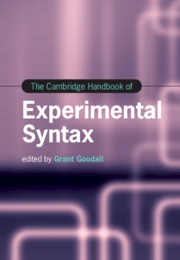Book contents
- The Cambridge Handbook of Experimental Syntax
- The Cambridge Handbook of Experimental Syntax
- Copyright page
- Contents
- Figures
- Tables
- Contributors
- Introduction
- Part I General Issues in Acceptability Experiments
- Part II Experimental Studies of Specific Phenomena
- Part III Experimental Studies of Specific Populations and Language Families
- 14 Acceptability Studies in L2 Populations
- 15 Judgments of Acceptability, Truth, and Felicity in Child Language
- 16 Acceptability and Truth-Value Judgment Studies in East Asian Languages
- 17 Acceptability Experiments in Romance Languages
- 18 Acceptability Studies in (Non-English) Germanic Languages
- 19 Acceptability Studies in Semitic Languages
- 20 Experimental Syntax and Slavic Languages
- 21 Acceptability Judgments in Sign Linguistics
- Part IV Experimental Syntax beyond Acceptability
- Index
- References
19 - Acceptability Studies in Semitic Languages
from Part III - Experimental Studies of Specific Populations and Language Families
Published online by Cambridge University Press: 16 December 2021
- The Cambridge Handbook of Experimental Syntax
- The Cambridge Handbook of Experimental Syntax
- Copyright page
- Contents
- Figures
- Tables
- Contributors
- Introduction
- Part I General Issues in Acceptability Experiments
- Part II Experimental Studies of Specific Phenomena
- Part III Experimental Studies of Specific Populations and Language Families
- 14 Acceptability Studies in L2 Populations
- 15 Judgments of Acceptability, Truth, and Felicity in Child Language
- 16 Acceptability and Truth-Value Judgment Studies in East Asian Languages
- 17 Acceptability Experiments in Romance Languages
- 18 Acceptability Studies in (Non-English) Germanic Languages
- 19 Acceptability Studies in Semitic Languages
- 20 Experimental Syntax and Slavic Languages
- 21 Acceptability Judgments in Sign Linguistics
- Part IV Experimental Syntax beyond Acceptability
- Index
- References
Summary
Formal acceptability experiments are particularly important for languages with smaller communities of linguists, including most Semitic languages. However, experimental studies of sentence acceptability in this language family are still rare, and focus on very few phenomena (notably wh-dependencies) and languages (mostly Arabic and Hebrew). This chapter reviews the extant literature on acceptability studies in Semitic languages. Special attention is given to studies on island constraints, resumptive pronouns – a conspicuous feature of Semitic –and their interaction, revealing a complex pattern of results. The scant literature on agreement and ditransitive structures is also discussed. The review also highlights some unexplored topics in Semitic syntax, which will benefit from future experimental work, including free word order, verbless sentences, and construct states. Finally, the chapter outlines some of the challenges facing researchers conducting experimental work in Semitic, including issues of diglossia, as well as technical challenges relating to script, online databases, and participant recruitment.
Keywords
- Type
- Chapter
- Information
- The Cambridge Handbook of Experimental Syntax , pp. 505 - 533Publisher: Cambridge University PressPrint publication year: 2021



